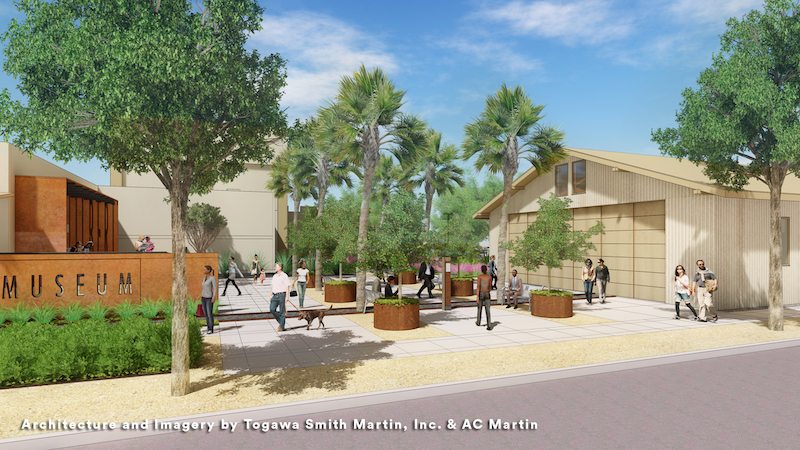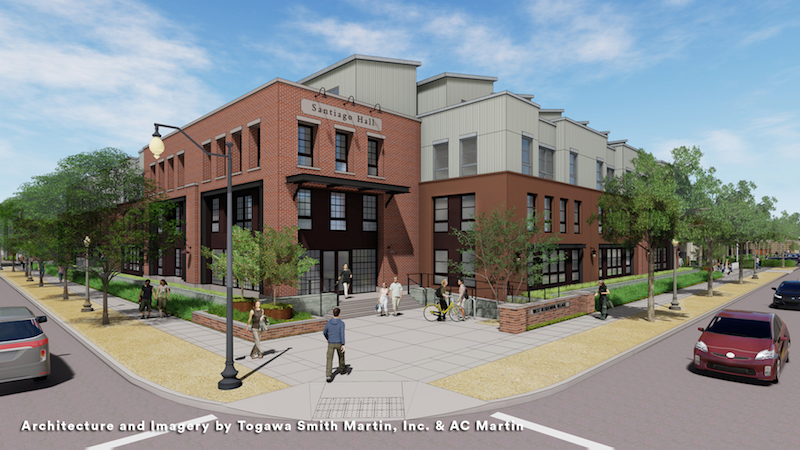A new 402-bed student apartment building for upperclassmen is being built alongside the adaptive reuse of a 100-year old packing house for Chapman University in Orange, Calif. The project is a collaboration between KTGY Architecture + Planning, Togawa Smith Martin, and AC Martin.
KTGY’s role for the project was to ensure project consistency with KTGY-prepared Specific Plan Design Guidelines, coordinate with the various design firms, provide design recommendations, and shepherd the project through the approval process.
 Architecture and Imagery by Togawa Smith Martin, Inc. and AC Martin.
Architecture and Imagery by Togawa Smith Martin, Inc. and AC Martin.
AC Martin, meanwhile, was in charge of the adaptive reuse of the Santiago Orange Growers Association Packing House. The front portion of the main packing room will become classrooms, offices, and the possible new home of Chapman University’s Hillbert Museum of California Art. The rear portion of the packing room will also be reserved for university uses but will also include the excavation of a large courtyard that will expose the basement level to the sunken courtyard area. The new courtyard will provide a common area for students living in the adjacent apartment building.
The Packing House’s exterior will be restored through the removal of later additions, the restoration of the original paint and colors, and the installation of building signage that replicates the original.
 Architecture and Imagery by Togawa Smith Martin, Inc. and AC Martin.
Architecture and Imagery by Togawa Smith Martin, Inc. and AC Martin.
Togawa Smith Martin designed the associated apartment building. The building’s design will reflect the industrial character of the Packing House and will provide 402 beds.
“In designing the new building, it was important to balance the demand for student housing with preserving the historic character of the site. The new building needed to be large enough to accommodate the number of beds without overwhelming the adjacent Packing House,” says Ken Ryan, KTGY Principal and Head of the firm’s Community Planning and Urban Design Studio, in a release.
 Architecture and Imagery by Togawa Smith Martin, Inc. and AC Martin.
Architecture and Imagery by Togawa Smith Martin, Inc. and AC Martin.
Related Stories
MFPRO+ Research | Sep 11, 2023
Conversions of multifamily dwellings to ‘mansions’ leading to dwindling affordable stock
Small multifamily homes have historically provided inexpensive housing for renters and buyers, but developers have converted many of them in recent decades into larger, single-family units. This has worsened the affordable housing crisis, say researchers.
Adaptive Reuse | Aug 31, 2023
New York City creates team to accelerate office-to-residential conversions
New York City has a new Office Conversion Accelerator Team that provides a single point of contact within city government to help speed adaptive reuse projects. Projects that create 50 or more housing units from office buildings are eligible for this new program.
Adaptive Reuse | Aug 31, 2023
Small town takes over big box
GBBN associate Claire Shafer, AIA, breaks down the firm's recreational adaptive reuse project for a small Indiana town.
Adaptive Reuse | Aug 17, 2023
How to design for adaptive reuse: Don’t reinvent the wheel
Gresham Smith demonstrates the opportunities of adaptive reuse, specifically reusing empty big-box retail and malls, many of which sit unused or underutilized across the country.
Adaptive Reuse | Aug 16, 2023
One of New York’s largest office-to-residential conversions kicks off soon
One of New York City’s largest office-to-residential conversions will soon be underway in lower Manhattan. 55 Broad Street, which served as the headquarters for Goldman Sachs from 1967 until 1983, will be reborn as a residence with 571 market rate apartments. The 30-story building will offer a wealth of amenities including a private club, wellness and fitness activities.
Adaptive Reuse | Jul 27, 2023
Number of U.S. adaptive reuse projects jumps to 122,000 from 77,000
The number of adaptive reuse projects in the pipeline grew to a record 122,000 in 2023 from 77,000 registered last year, according to RentCafe’s annual Adaptive Reuse Report. Of the 122,000 apartments currently undergoing conversion, 45,000 are the result of office repurposing, representing 37% of the total, followed by hotels (23% of future projects).
Urban Planning | Jul 26, 2023
America’s first 100% electric city shows the potential of government-industry alignment
Ithaca has turned heads with the start of its latest venture: Fully decarbonize and electrify the city by 2030.
Multifamily Housing | Jul 25, 2023
San Francisco seeks proposals for adaptive reuse of underutilized downtown office buildings
The City of San Francisco released a Request For Interest to identify office building conversions that city officials could help expedite with zoning changes, regulatory measures, and financial incentives.
Sustainability | Jul 13, 2023
Deep green retrofits: Updating old buildings to new sustainability standards
HOK’s David Weatherhead and Atenor’s Eoin Conroy discuss the challenges and opportunities of refurbishing old buildings to meet modern-day sustainability standards.
Multifamily Housing | Jul 11, 2023
Converting downtown office into multifamily residential: Let’s stop and think about this
Is the office-to-residential conversion really what’s best for our downtowns from a cultural, urban, economic perspective? Or is this silver bullet really a poison pill?

















